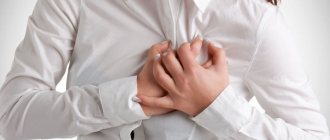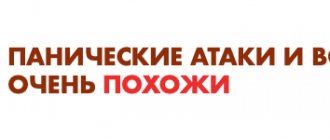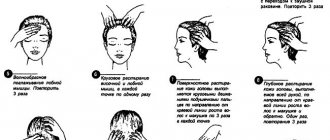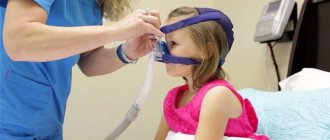Main signs of panic disorder
- Repeated attacks of panic attacks
are
sudden episodes of severe anxiety, episodes of inexplicable intense fear
(for example,
fear of death, fear of going crazy, fear of losing control of oneself,
and others).
Panic attacks
typically have
an unexpected onset
- without warning signs or apparent cause.
Specific fears
(
heart attack, stroke, fainting,
etc.), they force the patient to constantly measure his pulse, blood pressure, and do repeated electrocardiograms.
Panic attacks do not pose a threat to human life or health
, but they are a frightening condition in which
a person cannot control his feelings and emotions
and becomes completely defenseless. - Autonomic symptoms
developing suddenly and reaching their peak within the first 10 minutes: pulsations, palpitations, rapid pulse; - sweating;
- chills, tremors;
- feeling of lack of air, shortness of breath;
- difficulty breathing, suffocation;
- pain or discomfort in the left side of the chest;
- nausea or abdominal discomfort;
- dizziness, unsteadiness;
- weakness, lightheadedness, faintness;
- numbness or tingling sensation (paresthesia);
- waves of heat and cold;
- insomnia;
- feeling of derealization, depersonalization.
(in 60-80% of patients with panic attacks), which are caused by
pathological anxiety
.
There is also a clear relationship between the severity of the disease and concomitant sleep disorders. Patients with panic disorder complain of difficulty falling asleep
,
unrestoring sleep
, and characteristic
nocturnal panic attacks
.
In only 25% of patients, panic attacks occur exclusively while awake. Most patients experience an attack at some time during nighttime sleep, and 30-45% of them experience repeated episodes. 21% of patients experience sleep panic attacks, and in 54% panic attacks occur both during wakefulness and sleep. Nocturnal panic attacks
are manifested
by sudden awakening
(waking up from the feeling of being unable to inhale or exhale, forcing the patient to jump out of bed, open the window, lean his hands on the windowsill to use the accessory respiratory muscles; often experiencing dizziness and cramping of the fingers), all the symptoms characteristic of panic attacks .
There is a delay in bedtime, frequent awakenings, and a reduction in total sleep duration. Patients, fearing a recurrence of night panics, deliberately deprive themselves of sleep
, exacerbating the already pronounced insomnia symptoms, which leads to more serious disorders and generally
reduces the quality of life
of these patients.
Panic attacks and symptoms
Quite often, panic disorder is disguised as other diseases, which makes it difficult to quickly diagnose the disease. Patients experience the same sensations that appear in real neurological, cardiovascular and other serious pathologies.
A person who has recently experienced panic disorder, as a rule, does not know about it, so he often turns to doctors of various specializations for help. The patient is prescribed various examinations of the body, and in the end it turns out that he has no pathologies of internal organs, but despite this, the symptoms of a non-existent disease continue, even intensifying over time. In this case, we can talk about the presence of a panic attack or panic disorder.
Signs of a panic attack
The signs of this disease in most cases have a pronounced physical characteristic; the symptoms are similar to a heart attack, so many patients suspect heart pathology. However, even strong vegetative manifestations in this case are a consequence of dysfunctions of the nervous system and brain.
The main symptoms of a panic attack are anxiety attacks, which are accompanied by autonomic disorders (rapid heartbeat, chills, sweating). With an increase in the level of anxiety, the physiological parameters of the body, which are situational in nature, are often disrupted.
The severity of anxiety varies from a state of internal tension to pronounced panic. The average duration of an attack is 15-30 minutes. Anxiety reaches its maximum in the first 5-10 minutes and goes away as suddenly as it started.
Sometimes a panic attack develops against the background of situations that are uncomfortable for a person: being in a crowd or in a confined space.
For some people, attacks occur several times a day, for others - 1-2 times a month. Panic attacks often occur during the daytime. At night, anxiety attacks are more likely to bother strong-willed people who control their feelings while awake.
Approaches to the treatment of panic disorder
The most effective is the combined treatment of panic disorder - a combination of drug treatment with psychotherapy
.
Selection of an individual treatment regimen
is possible only after a thorough examination and is carried out taking into account all
the characteristics of the disease
.
When determining therapeutic tactics
the following factors are taken into account: duration of the disease, the patient’s attitude to pharmacotherapy, previous treatment experience, the nature and severity of emotional disorders, the nature of the psychogenic situation, the degree of social maladaptation, the presence of concomitant somatic disease.
Benzodiazepine tranquilizers are most effective for relieving PA.
.
Antidepressants are also effective in treating panic disorder
. It is recommended to use SSRIs (selective serotonin reuptake inhibitors) or SNRIs (selective serotonin and norepinephrine reuptake inhibitors).
An integral component of the treatment of panic disorder is psychotherapy, which is used both independently and in combination with pharmacotherapy. It is known that in a high percentage of cases the effect can be achieved only with the help of psychotherapy. The most important goal of psychotherapy is to gradually bring patients to an awareness of the essence of their psychological conflict and then to a gradual modification of previous inadequate schemes and attitudes and, ultimately, the development of a new, more harmonious and flexible system of views and relationships, more mature adaptation mechanisms, restoration of self-control and adequate response.
Non-medicinal products are also used
(physiogenic, psychotherapeutic)
methods for relieving
panic attacks:
- regulation of breathing (breathing into folded palms, breathing with the stomach - exhale longer, slower than inhale)
- distraction (concentrating attention on surrounding objects and events; physical activity; singing; walking; counting; auto-training)
- massage (shoulders, neck, little fingers, base of thumbs).
Neurogenic respiratory disorders: hyperventilation syndrome
History of the study of hyperventilation syndrome (HVS). The first clinical description of HVS was by Da Costa (1842), who summarized his observations of soldiers participating in the Civil War. He observed breathing disorders and various associated unpleasant sensations in the heart area, calling them “soldier’s heart”, “irritable heart”. The connection between pathological symptoms and physical activity was emphasized, hence another term - “effort syndrome”. In 1918, Lewis proposed another name, “neurocirculatory dystonia,” which is still widely used by therapists. Manifestations of HVS such as paresthesia, dizziness, and muscle spasms have been described; a connection between increased breathing (hyperventilation) and muscular-tonic and tetanic disorders has been noted. Already in 1930, it was shown that pain in the heart area with Da Costa syndrome is not only associated with physical activity, but also with hyperventilation as a result of emotional disturbances. These observations were confirmed during the Second World War. Hyperventilation manifestations were noted in both soldiers and civilians, which indicated the importance of psychological factors in the genesis of HVS.
Etiology and pathogenesis. In the 80–90s of the twentieth century, it was shown that HVS is part of the structure of the psychovegetative syndrome [1]. The main etiological factor is anxiety, anxiety-depressive (less often, hysterical) disorders. It is mental disorders that disrupt normal breathing and lead to hyperventilation. The respiratory system, on the one hand, has a high degree of autonomy, on the other, a high degree of learning ability and a close connection with the emotional state, especially anxiety. These features underlie the fact that HVS is in most cases of psychogenic origin; extremely rarely it is caused by organic neurological and somatic diseases - cardiovascular, pulmonary and endocrine.
Complex biochemical changes play an important role in the pathogenesis of HVS, especially in the calcium-magnesium homeostasis system. Mineral imbalance leads to an imbalance in the respiratory enzyme system and contributes to the development of hyperventilation.
The habit of breathing incorrectly is formed under the influence of cultural factors, past life experiences, as well as stressful situations suffered by the patient in childhood. The peculiarity of childhood psychogenies in patients with HVS is that they often involve respiratory dysfunction: children witness dramatic manifestations of attacks of bronchial asthma, cardiovascular and other diseases. In the past, patients themselves often have an increased load on the respiratory system: running, swimming, playing wind instruments, etc. In 1991, I. V. Moldovanu [1] showed that with HVS there is instability of breathing, a change in the ratio between the duration of inspiration and exhale.
Thus, the pathogenesis of HVS appears to be multilevel and multidimensional. A psychogenic factor (most often anxiety) disrupts normal breathing, resulting in hyperventilation. An increase in pulmonary and alveolar ventilation leads to stable biochemical changes: excessive release of carbon dioxide (CO2) from the body, the development of hypocapnia with a decrease in the partial pressure of CO2 in the alveolar air and oxygen in the arterial blood, as well as respiratory alkolosis. These shifts contribute to the formation of pathological symptoms: impaired consciousness, autonomic, muscular-tonic, algic, sensory and other disorders. As a result, mental disorders increase and a pathological circle is formed.
Clinical manifestations of HVS. HVS can be paroxysmal in nature (hyperventilation crisis), but more often hyperventilation disorders are permanent. HVS is characterized by a classic triad of symptoms: respiratory disorders, emotional disturbances and muscular-tonic disorders (neurogenic tetany).
The first are represented by the following types:
- "empty breath";
- violation of breathing automaticity;
- labored breathing;
- hyperventilation equivalents (sighs, coughing, yawning, sniffling).
- Emotional disorders are manifested by feelings of anxiety, fear, and internal tension.
Muscular-tonic disorders (neurogenic tetany) include:
- sensory disturbances (numbness, tingling, burning);
- convulsive phenomena (muscle spasms, “obstetrician’s hand”, carpopedal spasms);
- Chvostek syndrome II–III degree;
- positive Trousseau test.
In the first type of respiratory disorder - “empty breath” - the main sensation is dissatisfaction with inhalation, a feeling of lack of air, which leads to deep breaths. Patients constantly lack air. They open the vents and windows and become “air maniacs.” Respiratory disorders intensify in agoraphobic situations (subway) or social phobia (exam, public speaking). Breathing in such patients is frequent and/or deep.
In the second type - a violation of the automaticity of breathing - patients have a feeling of stopping breathing, so they continuously monitor the act of breathing and are constantly involved in its regulation.
The third type - shortness of breath syndrome - differs from the first option in that breathing is felt by patients as difficult and performed with great effort. They complain of a “lump” in the throat, failure of air to pass into the lungs, and constriction of breathing. This variant is called "atypical asthma." Objectively, increased breathing and irregular rhythm are noted. The act of breathing uses the respiratory muscles. The patient looks tense and restless. Examination of the lungs does not reveal any pathology.
The fourth type - hyperventilation equivalents - is characterized by periodically observed sighs, coughing, yawning, and sniffling. These manifestations are sufficient to maintain prolonged hypocapnia and alkalosis in the blood.
Emotional disturbances in HVS are mainly of an anxious or phobic nature. The most common disorder is generalized anxiety disorder. It, as a rule, is not associated with any specific stressful situation - the patient experiences various mental (feelings of constant internal tension, inability to relax, anxiety over trifles) and somatic manifestations for a long time (more than 6 months). Among the latter, respiratory disorders (usually “empty breath” or hyperventilation equivalents - coughing, yawning) may form the core of the clinical picture - along with, for example, algic and cardiovascular manifestations.
Respiratory disturbances reach a significant degree during a panic attack, when a so-called hyperventilation crisis develops. Disorders of the second and third types are more common - loss of automatic breathing and difficulty breathing. The patient experiences a fear of suffocation and other symptoms characteristic of a panic attack. To diagnose a panic attack, four of the following 13 symptoms must be observed: palpitations, sweating, chills, shortness of breath, suffocation, pain and discomfort in the left side of the chest, nausea, dizziness, a feeling of derealization, fear of going crazy, fear of death, paresthesia, waves heat and cold. An effective method for relieving a hyperventilation crisis and other symptoms associated with respiratory failure is breathing into a paper or plastic bag. In this case, the patient breathes his own exhaled air with a high content of carbon dioxide, which leads to a decrease in respiratory alkalosis and the listed symptoms.
Agoraphobia is often the cause of HVS. This is fear that arises in situations that the patient regards as difficult to help him. For example, a similar condition can occur in the subway, store, etc. Such patients, as a rule, do not leave home unaccompanied and avoid these places.
A special place in the clinical picture of HVS is occupied by an increase in neuromuscular excitability, manifested by tetany. Tetanic symptoms include:
- sensory disorders in the form of paresthesia (numbness, tingling, crawling, buzzing, burning sensations, etc.);
- convulsive muscular-tonic phenomena - spasms, contractions, tonic convulsions in the hands, with the phenomenon of “obstetrician’s hand” or carpopedal spasms.
These manifestations often occur in the picture of a hyperventilation crisis. In addition, increased neuromuscular excitability is characterized by Chvostek's symptom, a positive Trousseau cuff test and its variant, the Trousseau-Bahnsdorff test. The characteristic electromyographic (EMG) signs of latent muscle tetany are essential in the diagnosis of tetany. An increase in neuromuscular excitability is caused by the presence in patients with HVS of a mineral imbalance of calcium, magnesium, chlorides, and potassium, caused by hypocapnic alkalosis. There is a clear connection between increased neuromuscular excitability and hyperventilation.
Along with the classic manifestations of HVS, paroxysmal and permanent, there are other disorders characteristic of the psychovegetative syndrome as a whole:
- cardiovascular disorders - pain in the heart, palpitations, discomfort, chest compression. Objectively, lability of pulse and blood pressure, extrasystole are noted, and on the ECG - fluctuation of the ST segment; acrocyanosis, distal hyperhidrosis, Raynaud's phenomenon;
- disorders of the gastrointestinal tract: increased intestinal motility, belching of air, bloating, nausea, abdominal pain;
- changes in consciousness, manifested by a feeling of unreality, lipothymia, dizziness, blurred vision, in the form of fog or a grid before the eyes;
- algic manifestations, represented by cephalgia or cardialgia.
So, to diagnose hot water supply, confirmation of the following criteria is necessary:
- The presence of polymorphic complaints: respiratory, emotional and muscular-tonic disorders, as well as additional symptoms.
- Absence of organic nervous and somatic diseases.
- Presence of psychogenic history.
- Positive hyperventilation test.
- Disappearance of symptoms of hyperventilation crisis when breathing into a bag or inhaling a mixture of gases (5% CO2).
- Presence of tetany symptoms: Chvostek's sign, positive Trousseau test, positive EMG test for latent tetany.
- Change in blood pH towards alkalosis.
Treatment of hot water supply
Treatment of hot water supply is comprehensive and is aimed at correcting mental disorders, teaching proper breathing, and eliminating mineral imbalances.
Non-drug methods
- The essence of the disease is explained to the patient, they are convinced that it is curable (the origin of the symptoms of the disease, especially somatic ones, and their relationship with the mental state are explained; they are convinced that there is no organic disease).
- It is recommended to quit smoking and drink less coffee and alcohol.
- Breathing exercises are prescribed to regulate the depth and frequency of breathing. To carry it out correctly, several principles must be observed. First, switch to diaphragmatic abdominal breathing, during which the “inhibitory” Hering-Breuer reflex is activated, causing a decrease in the activity of the reticular formation of the brain stem and, as a result, muscle and mental relaxation. Secondly, maintain certain relationships between inhalation and exhalation: inhalation is 2 times shorter than exhalation. Thirdly, breathing should be rare. And finally, fourthly, breathing exercises should be carried out against the background of mental relaxation and positive emotions. At first, breathing exercises last for several minutes, then for quite a long time, forming a new psychophysiological breathing pattern.
- For severe hyperventilation disorders, breathing into a bag is recommended.
- Autogenic training and breathing-relaxation training are shown.
- Psychotherapeutic treatment is highly effective.
- Among the instrumental non-drug methods, biofeedback is used. The feedback mechanism with the objectification of a number of parameters in real time allows you to achieve more effective mental and muscle relaxation, as well as regulate your breathing pattern more successfully than with autogenic training and breathing-relaxation training. The biofeedback method has been successfully used for many years in the Clinic of Headache and Autonomic Disorders named after. acad. A. Veina for the treatment of hyperventilation disorders, panic attacks, anxiety and anxiety-phobic disorders, as well as tension headaches.
Medicinal methods
Hyperventilation syndrome refers to psychovegetative syndromes. Its main etiological factor is anxiety, anxiety-depressive and phobic disorders. Psychotropic therapy has priority in its treatment. In the treatment of anxiety disorders, antidepressants are more effective than anxiolytic drugs. Patients with anxiety disorders should be prescribed antidepressants with pronounced sedative or anxiolytic properties (amitriptyline, paroxetine, fluvoxamine, mirtazapine). The therapeutic dose of amitriptyline is 50–75 mg/day; to reduce side effects: lethargy, drowsiness, dry mouth, etc., the dose should be increased very slowly. Selective serotonin reuptake inhibitors have better tolerability and fewer unwanted side effects. The therapeutic dose of fluvoxamine is 50–100 mg/day, paroxetine is 20–40 mg/day. Their most common unwanted side effects include nausea. To prevent it or more successfully overcome it, it is also recommended to prescribe the drug at half the dosage at the beginning of therapy and take it with meals. Given the hypnotic effect of fluvoxamine, the drug should be prescribed in the evening; Paroxetine has less pronounced hypnogenic properties, so it is often recommended to take it with breakfast. The four-cyclic antidepressant mirtazapine has a pronounced anti-anxiety and hypnotic effect. It is usually prescribed at bedtime, starting with 7.5 or 15 mg, gradually increasing the dose to 30–60 mg/day. When prescribing balanced antidepressants (without pronounced sedative or activating effects): citalopram (20–40 mg/day), escitalopram (10–20 mg/day), sertraline (50–100 mg/day), etc., their combination is possible for a short period of 2–4 weeks with anxiolytics. The use of such a “benzodiazepine bridge” in some cases makes it possible to accelerate the onset of action of psychotropic therapy (this is important, given the delayed effect of antidepressants by 2-3 weeks) and to overcome the increase in anxiety symptoms that temporarily arise in some patients at the beginning of therapy. If the patient has hyperventilation crises during an attack, along with breathing into the bag, anxiolytics should be taken as abortive therapy: alprazolam, clonazepam, diazepam. The duration of psychotropic therapy is 3–6 months, if necessary up to 1 year.
Psychotropic drugs, along with a positive therapeutic effect, also have a number of negative properties: unwanted side effects, allergization, development of addiction and dependence, especially to benzodiazepines. In this regard, it is advisable to use alternative means, in particular, means that correct mineral imbalance, which is the most important symptom-forming factor in hyperventilation disorders.
As agents that reduce neuromuscular excitability, drugs that regulate calcium and magnesium metabolism are prescribed. The most commonly used are ergocalciferol (vitamin D2), Calcium-D3, as well as other medications containing calcium for 1–2 months.
The generally accepted view is that magnesium is an ion with clear neurosedative and neuroprotective properties. Magnesium deficiency in some cases leads to increased neuro-reflex excitability, decreased attention, memory, convulsive attacks, impaired consciousness, heart rhythm, sleep disorders, tetany, paresthesia, and ataxia. Stress - both physical and mental - increases the need for magnesium in the body and causes intracellular magnesium deficiency. A state of stress leads to depletion of intracellular magnesium reserves and its loss in the urine, since an increased amount of adrenaline and norepinephrine promotes its release from cells. Magnesium sulfate has been used in neurological practice for a long time as an antihypertensive and anticonvulsant. There are studies on the effectiveness of magnesium in the treatment of the consequences of acute cerebrovascular accident [2] and traumatic brain injury [4], as an additional remedy for epilepsy, and the treatment of autism in children [3, 7].
Magne B6 contains magnesium lactate and pyridoxine, which additionally potentiates the absorption of magnesium in the intestine and its transport into cells [6]. The implementation of the sedative, analgesic and anticonvulsant effects of magnesium-containing drugs is based on the property of magnesium to inhibit excitation processes in the cerebral cortex [5]. Prescribing Magne B6 both as monotherapy, 2 tablets 3 times a day, and in complex therapy in combination with psychotropic drugs and non-drug treatment methods, leads to a decrease in the clinical manifestations of HVS.
For questions regarding literature, please contact the editor.
E. G. Filatova, Doctor of Medical Sciences, Professor of MMA named after. I. M. Sechenova, Moscow
Treatment of sleep disorders in panic disorder
The use of hypnotics (drugs with a hypnotic effect) in a short course may be promising if sleep disorders predominate in the clinical picture in order to prevent the severity and chronicity of the disease.
Antidepressants are recommended for long-term use as sleeping pills without the risk of developing addiction and dependence.
with sedative effect and melatonergic drugs. In case of chronic insomnia, priority goes to non-drug treatment methods, among which the leading one is psychotherapy.











